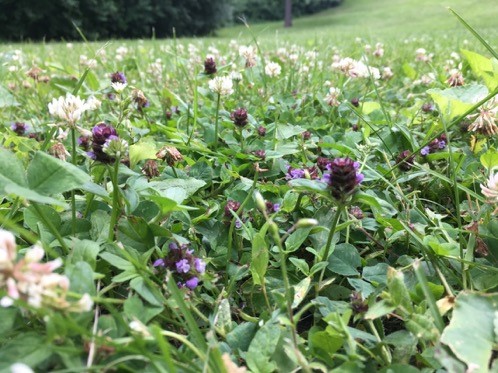The ultimate goal of the bee lawn project is quite simple: we want to reimagine the American vision for the turf lawn such that land managers may alter their turfgrass management practices to reduce inputs and support our bee-loved pollinators. Bee lawns (Figure 1) are turfgrass areas that include low-growing flowers that wild bees and honey bees use as forage for nectar and pollen. Through this project, we are comparing two types of lawns: lawns with pre-existing stands of Dutch white clover (Trifolium repens) and lawns that have been experimentally enhanced with a seed mix that contains Dutch white clover, self-heal (Prunella vulgaris), and creeping thyme (Thymus sepryllum). To determine the effectiveness of the experimental seed mix, a paired park design was used. First, Minneapolis was split into four distinct quadrants: Northeast, Northwest, Southeast, and Southwest. In each quadrant, there were two parks, one clover-only park, and one florally-enhanced park. Floral enhancements were not applied until after the first field season in 2016. In 2016, bees were collected off of naturally-occurring patches of Dutch white clover only, such that a baseline level of bee diversity could be recorded for each park.
In the fall of 2016, parks were florally enhanced with the seed mix via a dormant seeding in the late fall. Sections of parks with low foot traffic, high visibility, and low to moderate levels of shade were selected for the seeding. Floral enhancement sites were prepared with two methods of pre-seeding disruption, scalping and aeration. Scalping a lawn involves mowing the turf down to a height of one inch or less. Mowing turf down to this height before dropping flower seed improves the chances that flower seed will be able to make contact with the ground, improving the likelihood of germination. Aeration is the process of removing cores of soil from the ground to increase the flow of air, water, and nutrients throughout the surface, which also improve likelihood of germination. After these two practices were imparted onto the lawn, flower seed was spread evenly across an 800 m2 area at each of the florally-enhanced parks. In following field seasons, bee surveys were conducted at both clover-only parks, and florally-enhanced parks. In the 2017 field season, enhancements were successful at only two out of four parks. In 2018, enhancements were successful at three out of four parks.
In total, 3507 bees were collected throughout the three year survey of bees on lawn flowers. Fifty-seven unique bee species were collected off of Dutch white clover, while 60 unique bee species were collected off of florally-enhanced lawns. When comparing bee diversity at clover-only parks and florally-enhanced parks, we observed a trend where enhanced parks had greater bee diversity than clover-only parks (Figure 2). In addition to comparing which sites had greater bee diversity, we also analyzed trends in flower use to see if different bee communities existed on Dutch white clover and the enhancement flowers (Figure 3). Our results indicated that distinct bee communities existed on the white clover as compared to the bees on the self-heal and the creeping thyme.
This research gives significant insights as to how land managers can progress their lawn sustainability practices to support our pollinators. Previous efforts to improve the sustainability of lawn care have shown that using low-input grasses can reduce the amount of irrigation, fertilizer, and mowing required to maintain a healthy lawn. The results from this study indicate that allowing flowers to grow in a low-input lawn, or intentionally seeding flowers into a lawn, can support a diverse community of insect pollinators. Lawns with just Dutch white clover supported greater than 10% of all the bee species observed in the state of Minnesota. Furthermore, lawns florally enhanced with Dutch white clover, self-heal, and creeping thyme saw greater bee diversity than clover-only lawns, with distinct bee communities utilizing the self-heal and creeping thyme. With this in mind, we encourage homeowners and land managers from all backgrounds to embrace the flowers they see in their lawn, and even consider planting additional flowers, as they provide valuable forage to the honey bees and wild bees of our urban landscapes.


